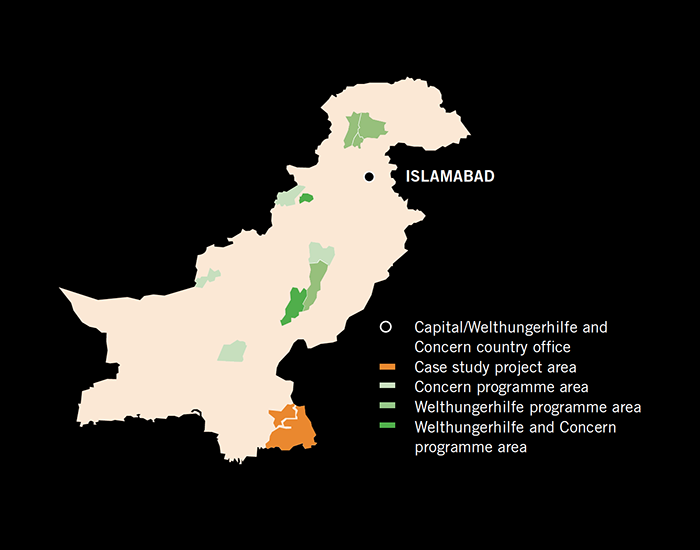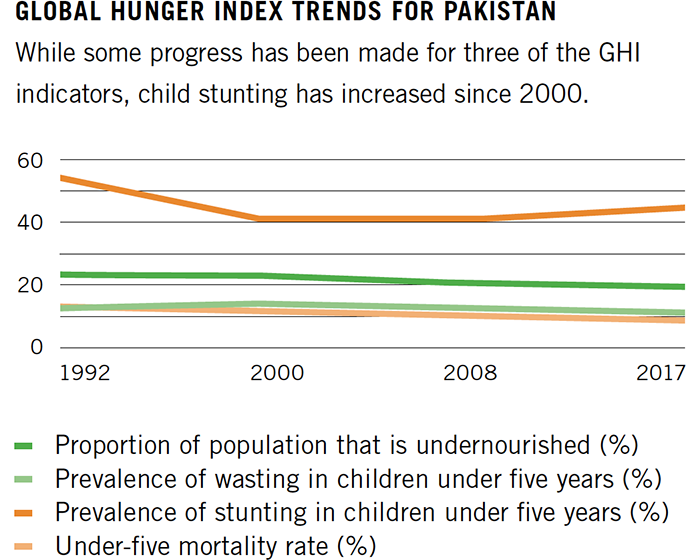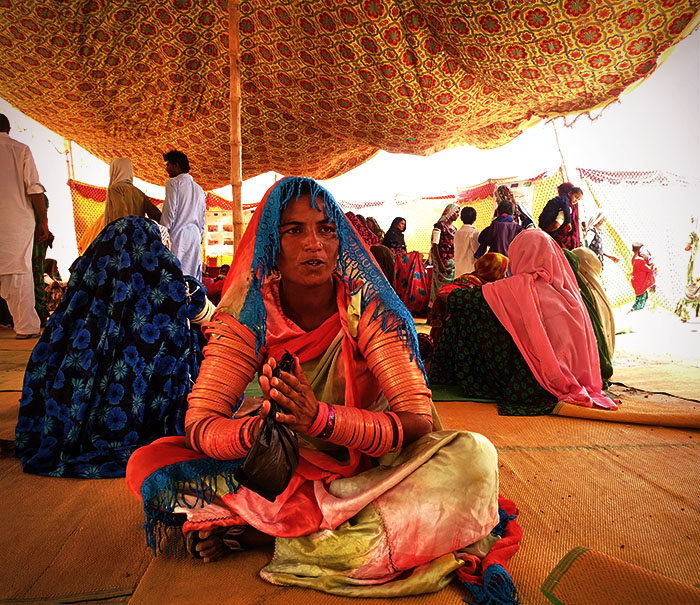Pakistan:
Fighting Drought and Inequality to Ensure Food Security
Pakistan is one of the countries most affected by disaster and climate change in the world, and over 39% of its population still lives in the shadow of multidimensional poverty.
Government of Pakistan, 2016

Pakistan has come a long way since its independence in 1947: the country’s population has grown from 33 million to 200 million, its literacy rate has increased from 11% to 58%, and its GDP is steadily rising (Government of Pakistan, 2017; World Bank, 2016). However, Pakistan is also one of the countries most affected by disaster and climate change in the world, and over 39% of its population still lives in the shadow of multidimensional poverty (Government of Pakistan, 2016). While in some districts of the country the effects of drought and poverty are hardly felt, in others they threaten communities with hunger.
In the 2017 Global Hunger Index, Pakistan ranks 106th out of 119 qualifying countries. With a score of 32.6, its status is ‘serious’ (bordering on ‘alarming’) (von Grebmer et al., 2017). A comprehensive overview of Pakistan’s nutrition situation was provided by the 2011 National Nutrition Survey, which showed that many of the most disconcerting statistics related to conditions in the southern province of Sindh, where 50% of children under the age of five were stunted and 19% suffered from wasting (Aga Khan University, 2011). Sindh’s nutritional problems have many causes, from a relative lack of investment in its population, infrastructure and facilities to the impact of the 2010 super-flood, which hit Sindh particularly hard.
Between 2013 and 2015, Sindh suffered from a severe drought, above all in Thar, a desert region that covers much of one district, Umerkot, and all of another, Tharparkar. In the most recent Human Development Index for Pakistan, Tharparkar was ranked in the bottom category. An in-depth assessment in 2015 concluded that virtually the entire population of Thar was living below the international poverty line of USD 1.90 per person per day. Thar has suffered primarily due to its inhospitable desert geography along with the fact that relatively speaking, it has received fewer resources to stimulate its development than other parts of the country. By way of contrast, the richest districts in Pakistan receive five times more public funds on average than the poorest (Hassan, 2016).
As the drought worsened through late 2014 into early 2015 and newspapers reported on the deaths of dozens of children, a number of donors responded to the crisis: the German government-supported Welthungerhilfe’s (WHH) activities, and, perhaps most significantly, the European Commission’s Humanitarian Aid and Civil Protection department (ECHO) funded a joint humanitarian intervention designed by Concern Worldwide (Concern) and WHH.
A Project Design that Fights Vulnerabilities and Inequalities

The Concern/WHH team consulted ECHO’s technical advisers and their respective local partner organisations in Thar (NGO’s Development Society, Research and Development Foundation and Thardeep Rural Development Programme) and conducted a thorough analysis of the multiple dimensions of hunger and inequality in the region. They concluded that the best approach to tackle malnutrition in Thar was via an integrated multi-sectoral intervention. This included nutrition-specific actions to offset the immediate causes, as well as nutrition-sensitive activities to strike at the root of the matter, namely increasing the availability of drinking water, boosting household income, and facilitating access to a nutritious diet. At the time the project started in 2015, the Global Acute Malnutrition (GAM) rate in the project area was 19.1% – well above the emergency threshold of 15%.
The issues surrounding inequality were more complicated. Given the limited duration of, and funding for, the project and the imperative to respond to basic needs, many of the dimensions of inequality in Thar simply could not be addressed. One example is the inequality in landholding, which reduces many Tharis to sharecropper status and limits their ability to prosper. Nevertheless, there were three dimensions of inequality that the project was able to alleviate.
The first was the manner in which inequalities in socio-economic status were exacerbated during drought. The poorest people of Thar found that their coping mechanisms became increasingly ineffective as the drought persisted: looking for more casual labour caused a glut of supply on the market and led to a precipitous fall in wages, meaning that these people had to work more days in order to earn the same income as during a normal year. They sold what few livestock they had, but the animals’ poor health meant that relinquishing these precious assets offered little return. After the drought continued into a second year, with the rain-fed harvest failing and giving yields of only 50% of a normal year, the poorest Tharis found credit and loans virtually impossible to come by.
The second dimension of inequality related to gender and the wide-reaching impacts of unequal power dynamics and social norms on women and girls. These issues range from restrictive mobility and early marriage and pregnancy to a lack of involvement in decision-making, minimal access to markets and little control over physical assets. Furthermore the greater dietary needs of pregnant and lactating women and of young children are not widely understood. When men migrate in search of work, women bear the burden of taking care of the remaining family, namely the children, the aged and the sick. Furthermore, when the animals are too weak and sick to draw water, women and children must do it instead, often from wells that are 300 feet deep or more.
The third dimension of inequality related to the distribution of resources and aid between regions. Concern and WHH worked to draw attention to the situation that was rapidly developing in Thar, and advocated for humanitarian funds from donors and UN agencies to be directed to the region at a time when the international spotlight was focused on the displaced people and host communities in Khyber Pakhtunkhwa province.
Addressing Inequality Through Our Work
 Sonari, Food and Nutrition Security Promoter, Aqlo Beel Village, Umerkot District
Sonari, Food and Nutrition Security Promoter, Aqlo Beel Village, Umerkot District
Nobody wanted to support our communities until this project started. Through the Cash-for-Training programme, mothers learn how to adequately take care of their own and their children’s nutrition, health and hygiene. Also, the additional money means we always have enough food. This way, the average weight of the babies increased by 0.5 to 1 kg. Sonari, Food and Nutrition Security Promoter, Aqlo Beel Village, Umerkot District
The project team implemented a number of activities designed to facilitate resilience-building among the poorest families. Large-scale vaccination and deworming campaigns were organised with the local government livestock departments in order to preserve the health of over 125,000 goats, sheep and camels that are the main assets for many Tharis and which provide meat, milk and even labour (camels are used to plough fields and draw well water). Meanwhile, funding of EUR 1.25 million was injected into the communities through Cash-for-Training and Cash-for-Work, leading to the construction of rainwater harvesting tanks and reservoirs, which compensated for the loss of income and food from the failed harvests and lost labour opportunities.
With fewer men having to migrate, the animals could be looked after better and became healthier, and more water could be harvested from rain or stored close by, thereby reducing the burden of work on women.
Other activities targeted women directly: levels of malnutrition were reduced through Community-based Management of Acute Malnutrition (CMAM), which administered nutritional treatment and supplements to malnourished mothers and children under the age of five years, and by educating the women about best practices in maternal, infant and child care and nutrition and hygiene measures. Given the reduced harvest and agricultural labour opportunities, the only quick means of increasing access to a more varied diet was to carry out conditional cash transfers via Cash-for-Training (in the form of awareness sessions that provided key nutrition-sensitive messages on nutrition, livestock and agriculture management).
In total, 95% of the trainees were women, who used the money to buy food or cover other needs and felt empowered by personally receiving the money.
Since the project formally began in May 2015 with funding of EUR 3.7 million for one year, a total of 61,693 children under the age of five and 27,494 pregnant or lactating women were screened for malnutrition. As a result, 6,070 severely acutely malnourished children, 11,398 moderately acutely malnourished children and 2,901 malnourished pregnant and lactating women were treated. In total, 15,288 households benefited from Cash-for-Training or Cash-for-Work schemes, and 8,117 households benefited from increased access to clean drinking water.
The Future:
Sustaining the Focus on Hunger and Inequality
The situation faced by families in drought-affected areas remains precarious: in 2016, the Government of Sindh – with support from the World Bank – started to increase its nutrition outreach activities. Nevertheless, rainfall during the monsoons of 2015 and 2016 was uneven, and thousands of households are still vulnerable after the depletion of their assets.
One of the most important outcomes of the project was the Household Economy Analysis (HEA). Concern coordinated this process in collaboration with the UN Food and Agriculture Organization (FAO) and with the participation of other UN agencies and NGOs, including WHH. Eight weeks of intensive field work and interviews with drought-affected families in four different drought-affected zones of Sindh, including two in Thar, provided the basis for the Analysis, which was more comprehensive than any previous drought assessment.
The HEA highlighted how inequalities are perpetuated by drought due to the fact that the coping mechanisms available to poor families are less effective than those available to better-off families. The document has become a reference for the government and various UN agencies, and was also used as the basis for the design of a follow-up Concern/WHH project, again funded by ECHO, to support the Government of Sindh’s nutrition outreach work. More importantly, the HEA highlights the type of resilience-building activities that will be necessary in the future. While there is a long way to go, recent progress shows that it is possible to reduce poverty, hunger and malnutrition in Sindh. That progress must now be sustained and strengthened so that further advances can be made in the fight against hunger and no one is left behind.
Bibliography
Aga Khan University Pakistan. 2011.
National Nutrition Survey Report.
Karachi, Pakistan.
Government of Pakistan. 2016.
Multidimensional Poverty Index.
Government of Pakistan. 2017.
Pakistan Economic Survey 2016-2017.
Hassan, M. 2016.
Escaping the Inequality Trap
Development Advocate Pakistan 3 (1): 1.
UNDP Pakistan. 2016.
Inequality: Missing from the Public Agenda.
Development Advocate 3 (2). Islamabad, Pakistan.
von Grebmer, K., J. Bernstein, N. Hossain, T. Brown, N. Prasai, Y. Yohannes, F. Patterson, A. Sonntag, S.-M. Zimmermann, O. Towey, C. Foley. 2017.
2017 Global Hunger Index: The Inequalities of Hunger.
Bonn, Washington, DC, and Dublin: Welthungerhilfe, International Food Policy Research Institute, and Concern Worldwide.
World Bank. 2016.
Pakistan Development Update: From Stability to Prosperity.
Washington, D.C.: World Bank Group.
Disclaimer
The boundaries and names shown and the designations used on the maps herein do not imply official endorsement or acceptance by Deutsche Welthungerhilfe or Concern Worldwide.
Author
Richard Blane (Welthungerhilfe Pakistan). This case study is part of the European edition of the 2017 Global Hunger Index and published by Concern Worldwide and Welthungerhilfe.